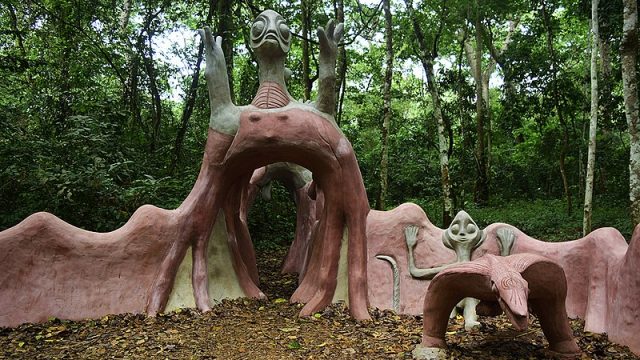While Nigeria isn’t well-traveled by leisure tourists, it’s a country rich in historical attractions. Its long history of kingdoms and empires and its diverse, ancient cultures (there are over 500 languages spoken in Nigeria) have all contributed to the abundance of historical and cultural sites. Here are 10 historic attractions in Nigeria you should visit.
National War Museum, Abia State
The National War Museum was created to preserve the immense number of relics from wars that Nigeria has waged through the centuries. Here you can see artifacts from the Nigerian Civil War in the 1960s, materials from the Niger Delta conflicts, and installations that depict weapons used in past empires around the country. The museum stands as a reminder of how recent the dark days of the country were.
Slave History Museum, Calabar
Calabar’s Slave History Museum is worth visiting in order to learn about the historical events that shaped this area, which was once a major slave port. The building houses numerous artifacts from the slave era, including remnants of ships and their cargo. It’s not the most uplifting visit, but you should still go to take it all in.
Nigerian National Museum, Lagos
This museum has one of — if not the — largest collections of Nigerian art and artifacts in the world. You can find everything from intricate wood carvings, to gigantic stone monuments, to bronze statues from indigenous groups. There are also exhibits dating back all the way to 550 B.C., from the Nok culture during Africa’s Iron Age.First Storey Building, Badagry
Overlooking the Marina waterfront in Badagry, this is the first multi-storey building ever built in Nigeria. It was constructed in 1845 by a Christian missionary by the name of Reverend Henry Townsend. It has historical importance as it coincides with the arrival of European missionaries who helped translate the Bible into Yoruba, forever changing the culture in the area.
Mbari Cultural Centre, Imo State
This center is extremely significant to Igbo cultural history and traditions. It’s sometimes referred to the “house of gods,” and is home to many sculpted figures from the Igbo people. You’ll also get an idea of what daily life was like for the ancient Igbo via the stories and artifacts found throughout the centre.
Badagry Heritage Museum, Badagry
Badagry was one of the biggest trading ports in West Africa from the 1500s onwards — it’s estimated that over 500,000 slaves passed through here on their way to the New World. There are eight galleries inside that take you through different periods of Badagry history, including the pre-slave era, the slave era, and the post-slave era. It’s a sobering reminder of the centuries of dark history that this area was witness to.
Emir Of Kano Palace, Kano
Kano is regarded as one of the most important historical places in the country, and the Emir’s (king’s) palace is one of its greatest buildings. The Hausa culture has existed in the region for over 1,000 years and has had a king since the year 999. If you go, try to time it with the vibrant Durbar festival, in which the Emir and his entourage are accompanied by bejeweled horsemen and a large parade.
Sukur Kingdom, Adamawa State
The Sukur Kingdom is a UNESCO World Heritage site located above the village of Sukur and situated on Mandara Mountain. It is an ancient settlement with a long history of iron work, and strong political institutions dating back to the 16th century. The grounds contain both above-ground and below-ground structures, along with several shrines and ceramics.
House Of Mary Slessor, Calabar
Mary Slessor wanted to follow in the footsteps of the great explorer David Livingstone, but ended up doing missionary work in Nigeria. Today, her house still stands in Calabar. She was famous for putting a stop to the killing of twins in southern Nigeria during the colonial era of the 1800s. You can also find her tomb nearby in the Mission Hill Cemetery.
Osun Sacred Grove, Osogbo
Located on the outskirts of Osogbo, this UNESCO World Heritage site is one of the most sacred locations in Yoruba culture. It’s one of the only remaining examples of the once-widespread Yoruba settlement design. Just a century ago, there were many in Yorubaland, but most have been destroyed. The interesting design and statues throughout reflect the idea of Yoruba cosmology, and every year there is a large celebration of the Yoruba gods nearby at the Osun River.
More from AFKTravel:
15 Amazing Nigerian Artists You Should Know About
The 15 Most Interesting Historical Sites In West Africa
QUIZ: How Much Do You Know About Nigeria?
This article was originally published on June 22, 2015.
Want to discover the finer side of Africa? Sign up for our weekly newsletter.

